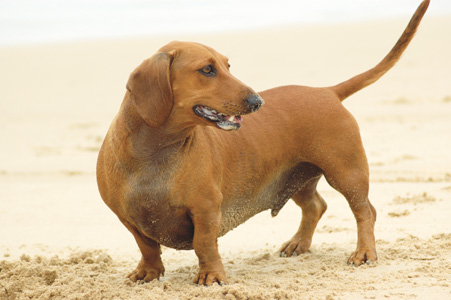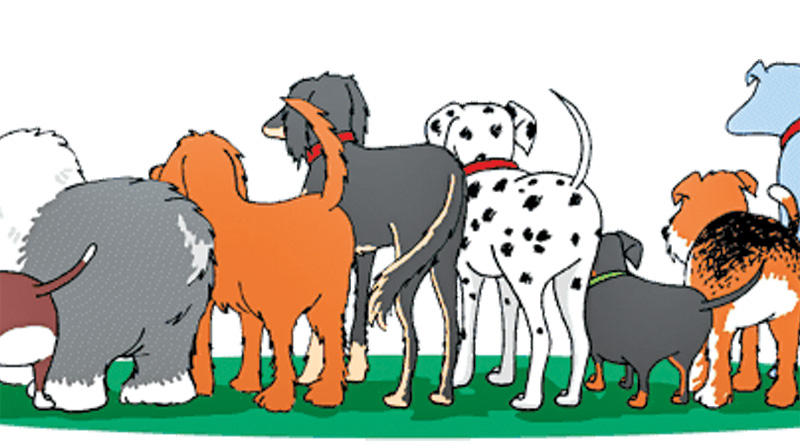Sheila was uneasy about the large dog that greeted her on the street. But his wagging tail laid all her apprehensions to rest. After all, if he was wagging his tail, he must be friendly, she assumed, and bent down to pat the dog. Without any warning, the dog lunged at her and grabbed her just below the eye.
Today, she has a scar to remember the dog by. But more than the pain of the bite, what confuses her is the wagging tail. Why would he wag his tail and then bite her? Doesn’t a wagging tail signify a friendly dog? Not always. Contrary to popular belief, a wagging tail does not always mean the dog is happy and friendly. And people like Sheila, sadly find out the hard way. So, if a wagging tail does not always indicate friendliness, what does it mean?
A dog’s tail position and motion is just one component of a complex system of body language that domestic dogs use, along with other cues such as head position, ear carriage, eyes and hackles, in order to communicate. A wagging tail can indicate excitement or agitation. But whether the dog means it as an invitation to play, or to warn another dog or person to stay away depends on other body language.
Do keep in mind that canine language goes far beyond the examples stated herewith. Individual pets develop their own techniques for communicating with us. It takes some observation to understand what your pet is saying, but it’s well worth the effort. Trying to understand canine body language will not just help prevent dog bites, but will also help improve the relationship between you and your dog.
Listed below are a few interpretations of what a dog’s wagging tail means:
 A vigorously wagging tail, where the dog’s entire nether region wags (especially Labradors, Boxers and Rottweilers) indicates a happy, friendly dog. The tail will be held up high or at level with the back a
A vigorously wagging tail, where the dog’s entire nether region wags (especially Labradors, Boxers and Rottweilers) indicates a happy, friendly dog. The tail will be held up high or at level with the back a
nd will be wagged in a sweeping motion.
 A tail that is held erect and wagged in a stiff manner indicates a dog could be uncertain or aggressively aroused. This dog, if pushed, can bite. The rest of the dog’s body language will be a dead give-away. The ears will be held upright, the body will be stiff and uninviting, the eyes will be fixed on the apparent threat and the muzzle might twitch. The lips are sometimes drawn back in a snarl and a low growl is heard.
A tail that is held erect and wagged in a stiff manner indicates a dog could be uncertain or aggressively aroused. This dog, if pushed, can bite. The rest of the dog’s body language will be a dead give-away. The ears will be held upright, the body will be stiff and uninviting, the eyes will be fixed on the apparent threat and the muzzle might twitch. The lips are sometimes drawn back in a snarl and a low growl is heard.
 A tail that is held low or even curled under the body indicates an apprehensive, frightened or nervous dog. The tail could be held still or can be wagged uncertainly in a twitching manner. The dog will prefer to avoid making eye contact with the threat and will look away, or even position his body sideways to the threat. The ears will be pinned back against the head and the dog will, in many cases, crouch low to express his submissive or nervous body language.
A tail that is held low or even curled under the body indicates an apprehensive, frightened or nervous dog. The tail could be held still or can be wagged uncertainly in a twitching manner. The dog will prefer to avoid making eye contact with the threat and will look away, or even position his body sideways to the threat. The ears will be pinned back against the head and the dog will, in many cases, crouch low to express his submissive or nervous body language.
Don’t always mistake this dog to be submissive and scared, if cornered, it will not hesitate to bite. A nervous dog’s bite is one of the worst bites a person can get.
- The Dark Side Of Pampered Pets: Is Your Kindness Harming Your Dog? - 16 March2024
- Kids And Preventing Dog Bites - 18 March2023
- Ordinary Dogs With Extraordinary Jobs - 13 August2022
